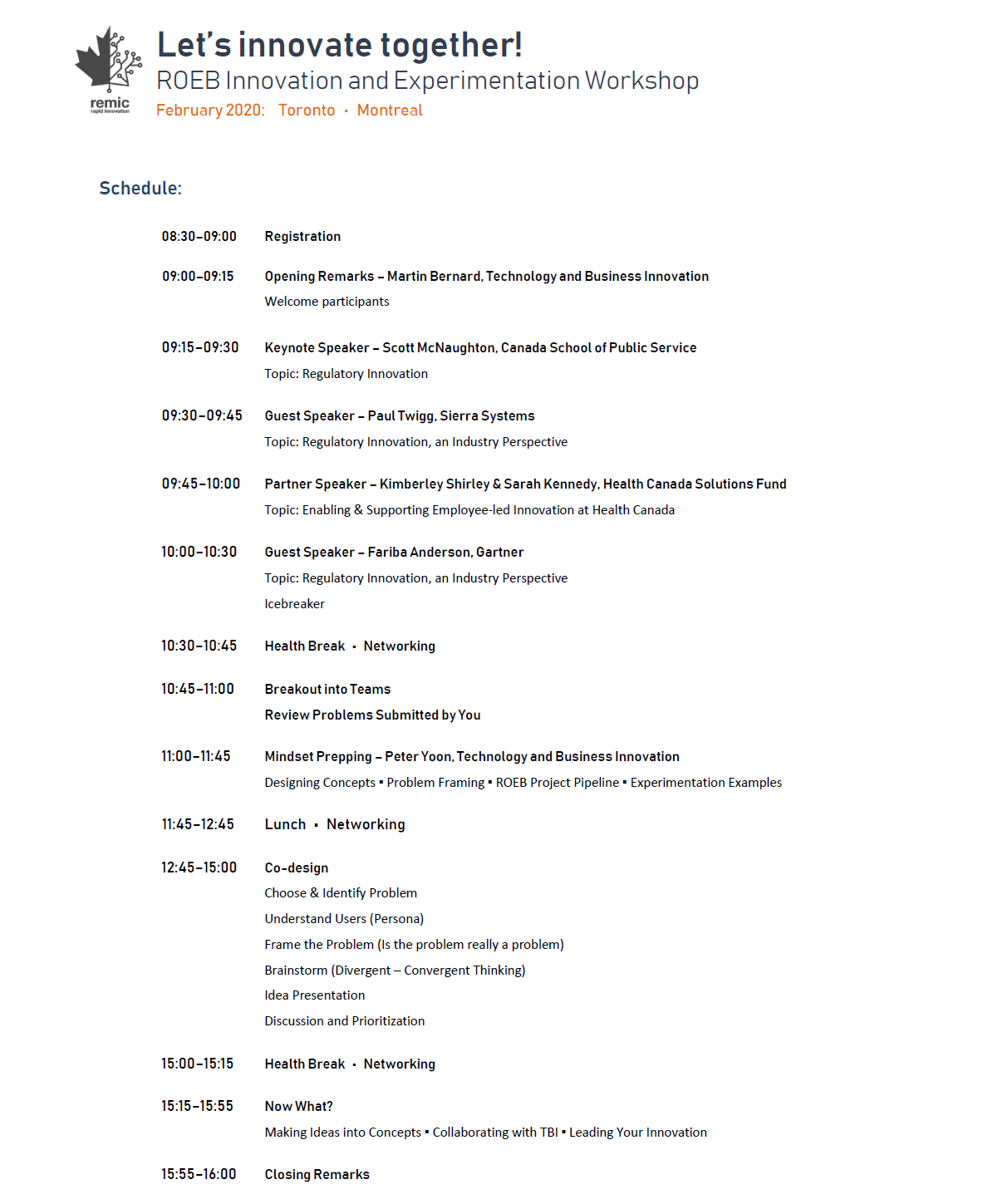Let’s Innovate Together
Introduction
Technology and Business Innovation (TBI) under the Planning and Operations Directorate (POD) is responsible for leading the development of the Regulatory Operations and Enforcement Branch (ROEB) investment plan, improving business, and solving problems. Investing in innovation is a major pillar for TBI; it aims to position the Branch as a leader in compliance and enforcement excellence by using innovative approaches to improve regulatory operations.
There is a new Innovation group in TBI called “remic” with a focus on novel approaches, testing via experiments to assess new technologies to potentially modernize and transform ROEB inspection service delivery systems. Remic brings together regulators, researchers, social scientists, data scientists, business and industry experts to collaborate, share, and co-create solutions to support ROEB objectives.
To support capacity building and co-learning within ROEB, TBI planned and executed two workshop sessions with an emphasis on sharing and exploring. The goal was to:
- Promote mindset, skills and behaviours necessary for innovation and experimentation
- Highlight employee-led experimentation (innovation) initiative
- Build knowledge and capacity in ROEB and be leaders in the C&E Transformation
- Nurture ideas into future projects (Submit ideas to Solutions Fund)
During February 2020, TBI visited Toronto and Montreal to facilitate the ‘innovation workshop’ sessions. This report will provide the detailed summary of the workshops and the collected results.
Purpose
In June 2019, the Government of Canada launched a public consultation on a number of initiatives that focused on modernizing the Canadian regulatory system. The intent of the process was to address the regulatory issues by encouraging innovation and competitiveness. A 2016 directive to the Deputy Head of the Federal Departments also ensures that the Government of Canada is committed to devote a fixed percentage of program funds to experimentation that brings new approaches and creates an environment of measurement, evaluation and innovation in program and policy design and delivery. There is a shift in the approach government is taking when investing for the future.
In order to leverage these Government of Canada opportunities ROEB has laid out its 2019-2022 strategic plan that focuses on three key priorities including modernizing the program delivery system, transformation of compliance and enforcement, and achieving excellence in people and workplace. As a result, ROEB is investing in experimentation to advance business processes in the digital era.
Under this plan, ROEB is creating an environment that is conducive to culture shifts to support change and evolution. As well, connecting and sharing with our national Branch partners with a purpose of co-learning and co-creating through experimentation is one of the first steps. The original intent was to visit six cities (Burnaby, Edmonton, Winnipeg, Toronto, Montreal, and Halifax); only Toronto and Montreal was visited – with a plan to visit the other cities in the future.
The purpose of the workshops were the following:
- Share ROEB learnings on experimentation to date, along with information from our corporate partners regarding innovation and experimentation relating to regulatory excellence;
- Expose participants to experimentation methodology, problem framing and design approaches to problem solving; and
- Leverage the workshop as a “launch pad” to co-create with our national partners to solve wicked problems through continuous learning, support, and partnerships.
The workshop was broken up into two portions. In the morning, participants heard presentations from various enablers of experimentation who shared their first-hand experience in developing an innovation project, including the lessons learned and the resources and support available. The workshop presented an introduction to understanding the innovation mindset, framing problems, and the process of experimentation. In the afternoon, participants took part in a hands-on workshop where they collectively chose a problem and applied design thinking principles. The problems they chose were from a list presented by the participants themselves.
The morning programming included the following:
- Share insight from internal and external partners:
- Martin Bernard, Opening Remarks
- Scott McNaughton, Canada School of Public Service, Showcasing Regulatory Innovation
- Fariba Anderson, Gartner, The Language of Change
- Paul Twig, Sierra Systems, Innovation Perspectives from Industry
- Sarah Kennedy, Health Canada’s Solutions Fund: Enabling Experimentation @ HC
- Kimberley Shirley, IMSD: Supporting Experimentation @ HC
- Provide overview on methods and approaches to problem framing and experimentation design
- Peter Yoon, Innovation Mindset, An Open Mindset to Experiment
The morning was to set the stage to provide perspectives from the Government of Canada model to experimentation to the approach adopted by Health Canada. All presentations are available at the TBI GCconnex page: https://gcconnex.gc.ca/file/group/40861893/all#61558995.
Workshop Session
The afternoon was dedicated to allow participants gain hands on experience applying a ‘design model’ to problem framing and idea generation. It focused on a process that put the emphasis on understanding the problem through an exploration of the persona – or the person that owns the problem. This is an approach to ensure that the right problem is being solved, and not the symptom(s).
As part of the process to register, each participant was asked to submit a problem or opportunity they are passionate about. This was used as the case studies for the workshop. The goal was to choose a problem and work through the problem by using the following 10 steps:
- Choosing a Problem
- Identify the Persona
- Refine the Problem
- What are the Needs?
- What can we Leverage?
- Measuring Success
- Brainstorm for Ideas
- Select Ideas for Testing
- The Pitch
- Ranking & Prioritizing
The traditional approach to problem solving tackles problems directly with an attempt to find a solution as quickly as possible. The exercise shifts the traditional approach by leaving the ‘problem solving’ portion near the end of the exercise; instead, the focus is put on understanding the people, their needs, available resources, and how success can be measured. In the following two sections, the results from each of the workshops has been summarized.

